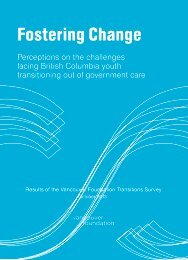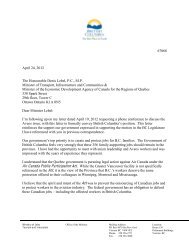from the ground up - The Tyee
from the ground up - The Tyee
from the ground up - The Tyee
Create successful ePaper yourself
Turn your PDF publications into a flip-book with our unique Google optimized e-Paper software.
spend <strong>the</strong> money wisely, says Hays. Clean EnergyWorks Portland, for example, received $20 million<strong>from</strong> <strong>the</strong> program to scale <strong>up</strong> its program, which gave500 homeowners in <strong>the</strong> city access to low-interestloans for energy retrofits, and allowed <strong>the</strong>m to pay itback on <strong>the</strong>ir utility bills.Now, Clean Energy Works Portland has become CleanEnergy Works Oregon, and is targeting 6,000 homesacross <strong>the</strong> state.Marlowe Kulley, an energy advisor with <strong>the</strong> city ofPortland who helped run <strong>the</strong> program, said <strong>the</strong>y usedpart of <strong>the</strong> funding to set <strong>up</strong> an IT program.“<strong>The</strong>re’s just a lot of data that has to come back andforth between a lot of different agencies,” explainsKulley. This includes information about utility billpayment and credit history, information <strong>from</strong> partnerutilities on energy use before and after, and information<strong>from</strong> contractors on <strong>the</strong> work that was done andits impact.“It’s a huge undertaking that requires a fair amount ofcapital to start <strong>up</strong>,” says Kulley. “Right now <strong>the</strong>re’sjust a lot of paperwork that’s being handled by hand...and it’s just not feasible when you’re looking at thousandsof units.”When asked whe<strong>the</strong>r programs like this one would bepossible without that federal stimulus funding, Hay’simmediate response is “No.”“Well, it would be possible,” he adds. “But it wouldbe happening at a very different scale than it is now.”Canada lags in green stimulusIn Canada, <strong>the</strong> federal government policies around energyefficiency and conservation have been spotty, atbest. <strong>The</strong> EcoEnergy program, which provides retrofitrebates and incentives to individual homeowners, hasstopped and started in various forms over <strong>the</strong> past severalyears, creating little stability for a retrofit market.Similarly, B.C.’s retrofit program, small rebates targetedtowards individual homeowners, was cancelledabr<strong>up</strong>tly in 2009, shaking <strong>the</strong> retrofit and renovationsector here.Funding uncertainty around <strong>the</strong>se popular programsindicates energy retrofits are not a priority for federalor provincial governments, which leaves Canadianmunicipalities to pick <strong>up</strong> <strong>the</strong> slack.Approximately eight years ago, <strong>the</strong> Pembina Institutebegan exploring how local governments could financeenergy efficiency and renewable energy retrofitsin <strong>the</strong>ir communities. In particular, <strong>the</strong>y lookedat Local Improvement Charges, or LICs, a financingmechanism already used by local governments. <strong>The</strong>secharges are levied on residents, via <strong>the</strong>ir propertytaxes, when neighbourhood-specific improvementsare undertaken, such as fixing sidewalks.“What we started to explore was whe<strong>the</strong>r <strong>the</strong>y coulduse this same mechanism, but use it as a way to provideloans to homeowners, so <strong>the</strong>y could do energyefficientretrofits on <strong>the</strong>ir home, and <strong>the</strong>y would pay itback over time through <strong>the</strong>ir property taxes,” explainsClaire Beckstead, who works in Pembina’s sustainablecommunities gro<strong>up</strong>.“<strong>The</strong> reason that this is sort of innovative and interestingis because <strong>the</strong> loan itself would be attached to <strong>the</strong>property, ra<strong>the</strong>r than <strong>the</strong> individual. <strong>The</strong> benefit and<strong>the</strong> cost of those retrofits would be passed on should<strong>the</strong> homeowner move.”Provincial regs ‘need clarification’Pembina even looked at testing this in Dawson Creek.What <strong>the</strong>y found was that <strong>the</strong>re was legal ambiguityaround whe<strong>the</strong>r communities in B.C. can use LICs forindividual homeowners.“<strong>The</strong> main challenge in B.C. around using localimprovement charges is that <strong>the</strong> Community Charterdoesn’t explicitly allow this use of local improvementcharges,” says Beckstead. “Provincially, <strong>the</strong>re doesneed to be clarification of <strong>the</strong> legislation.”Beckstead says while <strong>the</strong> province has shown aninterest in how LICs could be used to finance homeenergy retrofits, <strong>the</strong> message needs to come <strong>from</strong> localgovernments.“We’re working out a way to move this forward. Weknow what <strong>the</strong> program could look like, it’s just amatter of getting that explicit permission form <strong>the</strong>78








